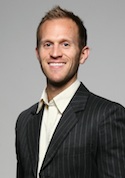Science Proves Why Men Love Your Curvy Backside
It seems like society has glorified having a big butt, and many women may be striving to achieve it.
From celebrities like Kim K, her sister Khloe, and Nicki Manaj's hit song "Anaconda," it might make you wonder why after all these years of trying to
reduce the size of your rump, it's now something many women (and men) want.
Here's the truth: research has shown for many years that men gravitate toward women with larger hips because it's a sign of fertility.
A recent study now shows why men are attracted to the way women's spines shape the size of your backside.
Published in the journal
Evolution and Human Behaviour, psychologists showed 300 men silhouettes of women with different angles of curves to their spines. The men were then asked to rate the images on how attractive they found each silhouette. Researchers found that men were more attracted to those with a spine curve of 45.5 degrees.
Are there any future research plans as a result of this study?
David Lewis, PhD, shares the research and just why men are attracted to your curvy backside.
Featured Speaker: David Lewis, PhD

Bilkent University, Psychology Department,
Dr. David Lewis is a scientist with degrees in both psychology and biology. His research investigates how evolution shaped certain physical features in men's and women's bodies to solve with survival- and reproduction-related challenges, and how the human mind evolved to detect these features and regulate mating attraction accordingly.
Transcription:
RadioMD Presents:HER Radio | Original Air Date: April 16, 2015
Host: Michelle King Robson and Pam Peeke, MD
It's all about her. Her body. Her mind. Her wellness. Her sex. Her relationships. Her aging. Her beauty. It's HER Radio starring acclaimed entrepreneur and women's advocate, Michelle King Robson and leading women's health expert, the doc who walks the talk, Dr. Pam Peeke.
PAM: Well, I love wild and crazy science and you know that, right, Michelle?
(laughter)
MICHELLE: This is wild and crazy.
PAM: Well, not only that, though. Because of who we are.
MICHELLE: I know.
PAM: And, the piece of anatomy that both of us have that, well, is the subject, front and center, of this new study.
MICHELLE: I know.
PAM: This study says why men love your curvy backside.
MICHELLE: Yikes.
PAM: Can you flipping believe this? Oh, yeah.
MICHELLE: Uh, yeah. Yeah. I can.
PAM: Hailing from Bilkent University Psychology Department, Dr. David Lewis and his team of scientists decided to kind of look at evolution and how it shaped men's and women's bodies in a survival reproduction challenge in the sense that what are men most likely to be attracted to in terms of women and their anatomy in order to kind of, as we say, keep this procreation going right and left. Whoa! Wee!
So, we have joining us, Dr. David Lewis. Dr. Lewis, welcome to HER Radio.
DR LEWIS: Thank you. Pleasure to be with you guys. I guess it is afternoon where you guys are.
PAM: Thank you. Well, we are...
MICHELLE: Yeah, I know.
PAM: We're enjoying it, whatever time it is. What we would love for you to do...
MICHELLE: We can't wait for this segment.
PAM: Oh, no, no, no. This is our star segment because you're going to understand in a minute why we're so terribly interested in this.
DR LEWIS: Alright.
PAM: So, Dr. Lewis, if you could do us a favor, tell us what this amazing study showed?
DR LEWIS: Okay. So, the main finding from this research is that it revealed the previously undiscovered preference that men have for specific angles of lumbar curvature in women's backs. The reason that that's so novel, and I'm happy to elaborate on these findings, is that in our research, we didn't just show that men had a preference for particular angles of lumbar curvature, but actually, that these preferences appear to be accounting for what we once thought of as a male preference for big butts.
PAM: Wait a minute. Wait a minute. Say that again. A male preference for big butts?
MICHELLE: Big butts?
PAM: So, Michelle and I. You can't see us right now because this is radio, but we are the buttless wonders.
MICHELLE: Oh, no. We're not. That's not true.
DR LEWIS: Well...
MICHELLE: We have great butts, Pam. Come on.
PAM: Does this mean nobody's ever going to be interested in us? Oh, my gosh. Let me wipe away the tears.
MICHELLE: My spine's curved though.
(laughter)
DR LEWIS: Precisely to the contrary. So, what our research suggests is that men do attend to this region on women's bodies, but it appears, or at least this research suggests, that it's not necessarily large buttocks that they're looking for...
MICHELLE: Thank god.
DR LEWIS:....but rather, they're looking for a combination of features that's associated with spinal curvature.
MICHELLE: Spinal curvature.
PAM: Tell us what that...Well, what is that angle that we're all looking for? In your study you found something interesting here.
DR LEWIS: Yeah. What we find, and this appears to be true across different women, is that men appear to like an angle of roughly 45 degrees. That's the angle that's formed between the thoracic or mid-back and the lower back.
MICHELLE: So, 45 degree angle?
PAM: Wait. Wait. I'm standing up right now. Look at my butt.
MICHELLE: I want to know.
PAM: I'm getting a ruler right out.
DR LEWIS: Yeah. I don't know if a ruler's going to be sufficient, but...
MICHELLE: A ruler?
DR LEWIS: But, if you're looking at it from that perspective, so when we say 45 degrees, we're measuring it according to how it's medical orthopedic literature.
MICHELLE: Okay.
DR LEWIS: But, if you're sort of just looking at somebody, really the angle that we'd referring to would be 135 degrees. So, if somebody with a perfectly flat back would be 180 degrees, 135 degrees would be a 45 degree deviation from that.
MICHELLE: Got it. So, what were your main findings in doing this study?
DR LEWIS: Sure. And, again, it's actually a combination of studies that sort of allow us to conclude what we did. So, in the first study, we took a variety of photos of women and then one of the members of our research team is an expert in image morphing. So, what he was able to do was to create multiple versions of each of these women, each of which essentially look like a realistic woman, but the only thing that was manipulated or changed between these different versions of the woman was her angle of lumbar curvature. So, we did that for a variety of women, presented this set of photographs in random order to a large group of men and all of those men rated the attractiveness of each woman on a scale, if I recall correctly, of 1-10. And, then...
MICHELLE: 10 being the best?
DR LEWIS: Yes. Ten being highly attractive and then... You'll have to forgive me for not remembering whether it was 0 to 10 or 1 to 10.
MICHELLE: Okay.
DR LEWIS: We wanted to pick something that was familiar to guys. Unfortunately, that's one way that guys sometimes think about women.
MICHELLE: They can count to 10? Oops. Did I say that?
PAM: Oh. That was cold.
DR LEWIS: Very nice come back.
PAM: Glacier. Glacier on that one.
DR LEWIS: I had no idea this was going to be this fun. You guys are great.
So, anyhow, what we did afterwards was we conducted some statistical analyses and what we were investigating was the relationship between the angle of women's spines and men's ratings of their attractiveness. What we found is that men's perceptions of women's attractiveness increased; that is, they saw women as more and more attractive as the angle increased to 45 degrees, but then once the angle started to exceed 45 degrees, men's perceptions of women's attractiveness started to go back down.
MICHELLE: Interesting.
PAM: Oh, how interesting. Fascinating. I just want to know if Kim Kardashian was one of the pictures that was shown.
DR LEWIS: She was not and she would be a confounding stimulus if she were in our study, because she appears, if I recall correctly, to have a pretty large degree of lumbar curvature and relatively large buttocks compared to the average woman.
MICHELLE: Yes.
DR LEWIS: So, she's got two different variables going on there.
MICHELLE: She does that. I just saw her in person. She's so beautiful, but I have seen her after she's had this surgery done and it's just been fascinating.
PAM: Augmentation of her butt. Yeah.
MICHELLE: Augmentation. Okay. Alright. Augmentation.
PAM: It's augmentation. But, you know what's really interesting? Let me ask this question, Dr. Lewis. So, does that mean like the super skinny models that we often times see in magazines and, you know, on the runways and whatever...
MICHELLE: Like me, Pam? Like me?
PAM: Super skinny. Oh, my gosh. No, but, you know? Really. These are basically kind of human clothes hangers. So, men. Would they find them attractive based upon what you're saying?
DR LEWIS: You know, that's a really good question and that's actually a possible new study that we could conduct is that we could compare the angles that we tend to see in these fashion models, even those who might be identified as relatively underweight, to see if one of the cues to attractiveness that they are exhibiting is this spinal angle. But, as of now, I can't really give you a solid answer as to whether those models, on average, differ in spinal curvature compared to the average woman. That's a great question.
PAM: Listen, honey. They have no spinal curvature.
MICHELLE: They have no study for you. They have no study. But, you know, let me ask you, because we only have a minute left. Tell us why you did the study. Why did you do the study? Just quickly.
DR LEWIS: Yeah. Okay. So, a combination of things since I've got 60 seconds. The first is that...
MICHELLE: You have 30.
DR LEWIS: ...anecdotally, you often hear of men attending to this region of the body, but, I mean, even Sir Mix-A-Lot's song itself is confused in trying to figure out which of the bodily features are being attended to. So, the song is Baby Got Back, but he tends to be talking about the butt. So anecdotally, we have these questions. There's something going on there, but we didn't know exactly what.
PAM: But, well, so, I think that that stimulus right there was, Baby Got Butt. I just love it. Everyone, we've been talking to Dr. David Lewis who has helped us understand why science proves men love your curvy backside. Look for that 45 degree angle. There's no question. Thank you, Dr. Lewis.
I'm Dr. Pam Peeke with Michelle King Robson.
MICHELLE: You can go to David Lewis' website, DavidMGLewis.com.
You're listening to HER Radio on RadioMD. Like us on Twitter. Follow us on Facebook. Stay well.

 Bilkent University, Psychology Department, Dr. David Lewis is a scientist with degrees in both psychology and biology. His research investigates how evolution shaped certain physical features in men's and women's bodies to solve with survival- and reproduction-related challenges, and how the human mind evolved to detect these features and regulate mating attraction accordingly.
Bilkent University, Psychology Department, Dr. David Lewis is a scientist with degrees in both psychology and biology. His research investigates how evolution shaped certain physical features in men's and women's bodies to solve with survival- and reproduction-related challenges, and how the human mind evolved to detect these features and regulate mating attraction accordingly.